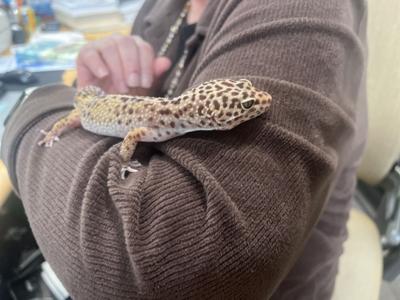On May 4, Chris Mick returned to the Hudson Public Library at night for a plate of food.
Mick — founder of Space St. Croix, which organizes space initiatives in the area — hosted a “May the 4th Be With You” event at the library earlier that day, and he came back to the library to bring various breakfast foods home to his daughter, he said.
And that’s when he saw it: Bagheera, the long-lost leopard gecko of the Hudson library, missing in action for around three months, found on the first floor of the facility, after escaping from its cage on the floor above. Bagheera’s reappearance raised more questions than answers — at least initially.
Question No. 1: Is the gecko dead? Bagheera answered that question fairly quickly. Mick gave it some water and warmth, and it started to open its eyes and perk up, as seen on a video he showed the Star-Observer.
Question No. 2: Whose leopard gecko is this? At first, Mick presumed he found Cheeto, another leopard gecko the library adopted once they thought Bagheera was dead. Mick answered that question himself, by going to a second-floor cage and seeing Cheeto still inside.
Question No. 3: How is Bagheera alive? People have tossed around theories, and it’s a broader question than some may think.
Leopard geckos use their tails in a variety of ways. They can ward off predators in self-defense, making it seem like the tail is actually its head. As the predator clamps on, the lizard gets rid of its tail and scurries away.
The gecko makes its tail look like its head by storing food reserves inside. A healthy leopard gecko has a tail the size of its head, which is about what Bagheera had before going missing, based on photos seen by the Star-Observer. For Bagheera, that is no longer the case after being found.
Bagheera lost much of the volume in its tail over the long journey, where it’s thought that the lizard may have been using the vent as a source of heat, as geckos are cold-blooded and require a high level of warmth. Some have speculated that Bagheera had fled the vent once the library turned the heating off for the season, which it did around the time the lizard was found.
Mark D. Scherz, who researches geckos and is a curator at the Natural History Museum of Denmark, weighed in via email, saying this is not very surprising.
“Three months without eating is not particularly unusual for a lizard, and Eublepharis are particularly suited for it specifically because of the fat reserves they store in their tails,” Scherz said.
Bagheera requires a certain amount of calcium, so Mick fed the lizard after finding it. And while the library had ostensibly given up some hope of finding Bagheera at a point, the employees and volunteers kept its cage — just in case.
Library-goers can see Bagheera in that very cage now, along with Cheeto, Bindi and Toothless, the last of which is a bearded dragon and not a spotted gecko.
OK, question No. 4: What’s with the reptiles?
Librarian Joan Bushman said the library hosts a Snake Discovery every summer, and the program was so popular with kids that library workers decided to house reptiles themselves.
“The idea of having a library pet is great, but so many people are allergic to something with fur,” Bushman said. And some people are allergic to reptiles, but those cases are very rare.
Now, to question No. 5: How did Bagheera get out? People have multiple theories for this one, too.
Library workers and affiliates claimed that Bagheera’s cage was found locked and without the lizard inside in February, and the library quickly announced it was missing on Facebook afterward. The workers sometimes take lizards out of cages, allowing the reptiles to roam the library. There’s also a chance that someone else took Bagheera out, then forgot about it. Whether it was evil intent or an accident, we will probably never know the answer to this question.
And though Bagheera did not provide comment for this story, the lizard appeared to be in good spirits when reached for a photo opportunity with the Star-Observer on Thursday.
“It’s amazing,” Bushman said. “It’s a bloody miracle, really.”



(0) comments
Welcome to the discussion.
Log In
Thank you for taking part in our commenting section. We want this platform to be a safe and inclusive community where you can freely share ideas and opinions. Comments that are racist, hateful, sexist or attack others won’t be allowed. Just keep it clean. Do these things or you could be banned:
• Don’t name-call and attack other commenters. If you’d be in hot water for saying it in public, then don’t say it here.
• Don’t spam us.
• Don’t attack our journalists.
Let’s make this a platform that is educational, enjoyable and insightful.
Email questions to [email protected].